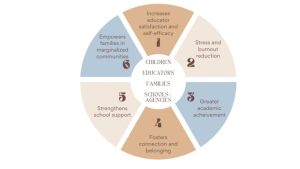3 Six Reasons This Work is Important

- Family Partnership makes our work as educators and clinicians more satisfying, informing practice in ways that increase professional self-efficacy.
- When children engage with professionals who find their job satisfying, they are more likely to engage in opportunities that match their developmental and academic needs.
- Career satisfaction and self-efficacy increase professional retention and commitment. When teachers and clinicians remain in their jobs, they are able to build stronger skills and relationships with the community, becoming more effective professionals.
- Educators and clinicians who demonstrate a passion for their work trust and develop trust with families.
- When educators and clinicians feel professionally satisfied and successful, they are more likely to remain in their schools/agencies, resulting in greater outcomes for children.
2. Proactive partnership work makes the work less stressful, leading to reduced burnout and greater retention in the helping professions.
- Children benefit from educators and clinicians who have a positive perspective of their profession and do not feel burnout.
- Experienced educators and clinicians have many strategies and skills that novice professionals have yet to build, including the ability to mentor their less experienced peers.
- Professionals who work in strong partnership with families have greater access to information to inform their work.
- Families benefit from professionals who have information about the school/ clinic/ agency and community based on multiple years of working in the community.
- Schools/agencies/ clinics benefit from employing professionals who find joy in their work. Reducing turnover and increasing retention allows for growth over time, rather than acclimating new professionals to the school or agency. This growth can lead to new ideas and can build on existing strengths.
3. Family Partnership is closely correlated with greater academic achievement.
- When children, families, clinicians, and educators all work together to build a trusting environment, children are more likely to attend and participate, leading to greater outcomes.
- Educators who are able to communicate information about content, due dates, and the importance of academic information to families will see greater benefits for their students.
- Families may not always immediately understand all aspects of their children’s schoolwork (just think about how much multiplication has changed over the years!). Families benefit from educators who provide opportunities to develop an appreciation for the style and content of academic work.
- Schools/agencies are encouraged to provide opportunities for families to engage with academics, such as math and literacy nights, and other fun activities when engagement is high.
4. Family partnership has measurable benefits for children’s sense of connection and belongingness within schools.
- When children know that their important adults trust educators and clinicians, they are more likely to feel a sense of belonging and trust. They may seek out other children, ask questions of adults, and feel that they are a member of the community.
- When you have built a relationship with a child who feels safe, you can challenge them to reach their potential.
- When children feel a sense of safety and belonging, families may engage more, ask questions, and trust the professionals who support them. Families may then feel comfortable asking for support when needed or exploring additional opportunities for their child to engage (e.g., co-curricular activities).
- Children and families are more likely to engage in extracurricular activities, and work towards the betterment of the school/agency for all families and children.
5. Partnership work creates and strengthens support for schools, agencies, and clinics.
- Educators, clinicians, and families who engage in true partnerships have a shared understanding of goals to support the education of children.
- Children thrive in environments where they receive consistent messages from all adults.
- When educators and clinicians partner with families, they can reinforce shared goals at home so children know how to respond to expectations that lead to successful outcomes.
- Schools/ agencies can spend time in proactive support and growth rather than remediation of difficulties when true communication and partnership exists. Families can also be strong advocates for the school or agency when they feel heard.
6. Families in marginalized communities are empowered when schools, agencies, and clinics partner with them.
- Children are more successful when families have the resources to support learning at home and contribute to learning experiences.
- Families feel safe and supported when professionals provide information and solicit input from the important adults who are their children’s first and foremost teachers.
- Educators and clinicians are more effective when all families are able to participate in and provide input about their children’s education and care plan.
- Schools/ agencies can effectively support children when families provide valuable information about their children and reinforce academic and social-emotional goals at home.
Media Attributions
- Untitled presentation

